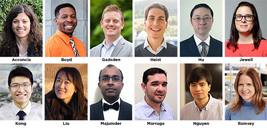 |
Date Announced: 18 Dec 2018
12 distinguished early-career professionals represent the broad spectrum and reach of photonics, from Industrial Sensing & Measurement and Electronic Imaging & Signal Processing, to Optical Design & Engineering, Astronomy, and Micro/Nano Fabrication.
Pictured right, the 2019 DCS Rising Researchers (details below).
BELLINGHAM, Washington, USA and CARDIFF, UK – SPIE, the international society for optics and photonics, welcomes 12 distinguished early-career professionals as its 2019 DCS Rising Researchers. The awards will be presented in April 2019, at SPIE Defense + Commercial Sensing (DCS) in Baltimore, Maryland.
Now in its third year, the SPIE Rising Researcher awards program recognizes early-career professionals who are conducting outstanding work and making important advances in product development or research in the areas of defense, commercial, and scientific sensing, imaging, optics, or related fields.
The Rising Researchers – all of whom are presenting at SPIE DCS 2019 – were selected by a team of Defense & Commercial Sensing Steering Committee members, conference chairs, past recipients, and SPIE leadership. Assessments are based on impact statements provided by entrants, research report abstracts submitted for the event, CVs, videos, and recommendations from a supervisor or senior colleague.
Each winner receives a fee waiver for full conference registration and a half-day course at the event, a one-year SPIE Membership, and other recognitions.
The 2019 DCS Rising Researchers, their affiliations, and their research areas are as follow:
"The Rising Researcher program continues to recognize outstanding technical contributions from early career professionals in the DCS community," said SPIE Director of Science & Technology Bob Hainsey.
"Their work represents a level of excellence that differentiates them from their peers, and their presentations highlight another strong conference program. This year's winners reflect the diversity of DCS attendees and the breadth of the technical content, with award recipients coming from academia, government labs, and industry, in disciplines that include infrared optics, single photon counters, novel photonic materials, biomedical sensors, and machine learning."
For more on our Rising Researchers and their work, please visit http://spie.org/RisingResearchers
About SPIE
SPIE is the international society for optics and photonics, an educational not-for-profit organization founded in 1955 to advance light-based science, engineering, and technology. The Society serves 257,000 constituents from 173 countries, offering conferences and their published proceedings, continuing education, books, journals, and the SPIE Digital Library. In 2018, SPIE provided more than $4 million in community support including scholarships and awards, outreach and advocacy programs, travel grants, public policy, and educational resources.
E-mail: daneets@spie.org
Web Site: www.spie.org
| © 2025 SPIE Europe |
|